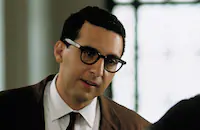Director William Friedkin has called To Live and Die in L.A. (1985) one of the few films that came closest to his original vision. The plot deals with Secret Service agents on the trail of a deadly Los Angeles counterfeiter. But the real attraction for Friedkin was the underlying tension between the two sides and the shades of grey created by shifting sympathies and motivations, in particular the growing corruption of the agents.
“All of the films...I have chosen to make,” Friedkin said, “are about the thin line between good and evil. And also, the thin line that exists in each and every one of us. That’s what my films are about. That’s what To Live and Die in L.A. is about. There is a thin line between the policeman and the criminal. The best cops are always crossed. The best cops are the ones who are able to think like criminals. But for a quirk of fate, they might have been criminals.”
Friedkin had read Gerald Petievich’s novel in galley form and immediately wanted to make the movie. Petievich was a 15-year veteran of the Secret Service on the verge of retiring from the agency to become a full-time novelist. Friedkin liked not just the authenticity of the criminal pursuits, including counterfeiting, that Petievich explored in his writing but also the general world of Secret Service agents, which could be bizarre in that the agency’s mission covers such a broad range of activity. “The thing that fascinated me,” Friedkin said, “was the surrealism in the life of a Secret Service agent: guarding the President of the United States one day, playing cards with him and telling jokes, and the next day chasing some guy down in a bad neighborhood for 50 dollars’ worth of bad credit cards.”
Friedkin acquired the book’s rights and wrote a draft of a screenplay, but he consulted with Petievich so much that he decided to give him a writing credit, too. MGM supplied a budget of only $6 million, meaning Friedkin was unable to cast major stars. Instead, he turned the entire project into as much of a stripped-down, guerilla-style production as he could. He was lucky to find – and smart to recognize the talents of – future television star William S. Peterson, here in his first lead role as Agent Richard Chance, and rising actor Willem Dafoe as the counterfeiter Rick Masters. Friedkin said Petersen’s intelligence leapt out at him during the audition and that Dafoe’s performance was so deep and complex that even during filming Friedkin adjusted the character to better suit Dafoe’s great range. A year later, Dafoe would score his first Oscar nomination for Platoon (1986), elevating him to stardom.
To Live and Die in L.A., shot entirely on location throughout Los Angeles, was filmed quickly to provide a sense of urgency and immediacy. “Our movie is about a counterfeiter operating in one big counterfeit of a city,” production designer Lilly Kilvert explained. “We were searching for something that isn’t usually associated with Los Angeles – a look of overall urban decay. On the surface, the city looks very clean and bright, but underneath, it’s crumbling, gritty, dull and impermanent.”
Friedkin did what he had to do to get the shots he desired. For one scene at Los Angeles International Airport, Petersen performed a stunt by running along the top of the divider between moving walkways, while in pursuit of a character played by John Turturro. After a rehearsal, airport security personnel told Friedkin not to do it again, as it went against their safety regulations. Friedkin quietly told Petersen to do the stunt again the same way, and after yelling “cut,” Friedkin simply pretended to yell at Petersen for having done it again.
An admired counterfeiting montage drew much praise for feeling so authentic. Friedkin later said that in order to achieve that authenticity, Petievich used his influence to get a real-life counterfeiter paroled from jail, just so he could create the fake money they needed. Friedkin even used the counterfeiter’s hands in the shots that didn’t require Dafoe’s face. The film’s most famous sequence, however, is its car chase. Devised by Friedkin 14 years after his masterful The French Connection (1971), it is another edge-of-your-seat chase that includes driving against traffic on a Los Angeles freeway. As elaborate as it looks, Friedkin said that even this was filmed relatively quickly and as simply as possible.
During production, Friedkin heard the music of the popular British new wave band Wang Chung and decided their sound could work well with the film. “I told them to make [the score] their impressions of the script,” Friedkin later told critic Jeffrey Anderson. “I cut the movie to their music. It really dictated the nature of certain sequences. I think the music was unique at the time and still is. When you get a good score, it’s inseparable from the rest of the film.”
To Live and Die in L.A. grossed $17 million, turning a profit on its $6 million budget, but it was not viewed as particularly successful. “A rich man’s Miami Vice,” said Variety, “engrossing and diverting enough...but overtooled.” The New York Times described the film as “Mr. Friedkin at his glossiest, a great-looking, riveting movie without an iota of warmth or soul. On its own terms, it’s a considerable success, though it’s a film that sacrifices everything in the interests of style.”
In later years, however, the film developed a cult following. With its pastel color scheme by cinematographer Robby Muller and gritty urban atmosphere, it has since been reassessed as an overlooked ’80s action classic and a key film in the neo-noir movement underway in Hollywood at the time.


















